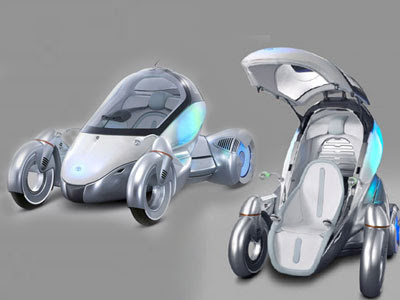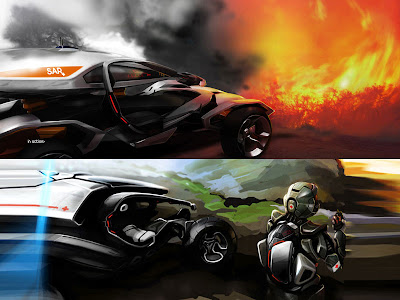The Tatra 903 Concept is premium fuel cell/electric vehicle with "a unique combination of emotional styling and aerodynamics efficiency."

The car takes inspiration from the Czech automotive brand Tatra, historically famous for its unforgettable aerodynamics and revolutionary technical solutions.
"The water drop shaped back refers to one of the most characteristic values of Tatra, the aerodynamics – same as covered rear wheels. "It may look retro, but in the term of aerodynamic optimisation it has its own purpose."The A-pillar has moved in the axis of the car – again, not just a quotation of split screen theme pointing back to the original models, but certainly a safety factor designed to offer a better view from the car." describes
Mike Jelinek.
"I didn't want to refer to any model from the history of this legendary manufacturer, but I tried to catch something like the spirit of Tatra cars and bring it to aesthetics a the 21st century." said Jelinek.
Tatra T87 (1936-1950)
Nowadays, Tatra doesn't produce any passenger cars, just heavy trucks, but the heritage hidden in the extraordinary cars is still waiting for rediscovery.
More information can be found in the No. 14 issue of the Czech car design magazine AutoDesign&Styling.
About the Designer
Mike Jelinek worked in many roles for design studios at Skoda Auto, Volkswagen, Citroën, GME, Daimler just to name few.
Today he works as a senior consultant for conceptual design at
Autodesk where he is responsible for the automotive design customers.
 The Arbitrage Cars are manufacturing a small series production for both the Barchetta and GT (hardtop) version. This version is based on their Arbitrage GT chassis. This design was approved by Giotto Bizzarrini.
The Arbitrage Cars are manufacturing a small series production for both the Barchetta and GT (hardtop) version. This version is based on their Arbitrage GT chassis. This design was approved by Giotto Bizzarrini. Bizzarrini for long has been associated with exclusive performance cars, and with their name being used in this 2008 concept, it adds a sense of history to the vehicle. While the ‘Livorno’ is taken from the Italian city in which Bizzarrini is residing currently.
Bizzarrini for long has been associated with exclusive performance cars, and with their name being used in this 2008 concept, it adds a sense of history to the vehicle. While the ‘Livorno’ is taken from the Italian city in which Bizzarrini is residing currently. P538 in the car name is picked to pay homage to a limited race car which was built by Bizzarinni built in 1960’s.
P538 in the car name is picked to pay homage to a limited race car which was built by Bizzarinni built in 1960’s. It’s the lattice framework in which the engine is placed. This is directly behind the driver thus 8 race-like intake trumpets highlight the location of this powerful engine. This pokes through the engine cover just behind the cockpit.
It’s the lattice framework in which the engine is placed. This is directly behind the driver thus 8 race-like intake trumpets highlight the location of this powerful engine. This pokes through the engine cover just behind the cockpit. The manufacturers are planning a small series production for both the Barchetta and GT (Hardtop) version.
The manufacturers are planning a small series production for both the Barchetta and GT (Hardtop) version.










 Concept Design Titan Car
Concept Design Titan Car Concept Design Superhero Car
Concept Design Superhero Car Concept Design Peugeot Car
Concept Design Peugeot Car
 New Design Concept Renault Car Future
New Design Concept Renault Car Future New Design Concept Peugeot Car Future
New Design Concept Peugeot Car Future New Design Concept Hyunda Car Future
New Design Concept Hyunda Car Future New Design Concept Future Car Ideas
New Design Concept Future Car Ideas New Design Concept Embryo Car Future
New Design Concept Embryo Car Future








 Design Interior Cockpit Porsche 911 Turbo TechArt
Design Interior Cockpit Porsche 911 Turbo TechArt Porsche 911 Turbo TechArt with based on Design
Porsche 911 Turbo TechArt with based on Design Porsche 911 Turbo TechArt on Back Body
Porsche 911 Turbo TechArt on Back Body Porsche 911 Turbo TechArt in Beside
Porsche 911 Turbo TechArt in Beside

























